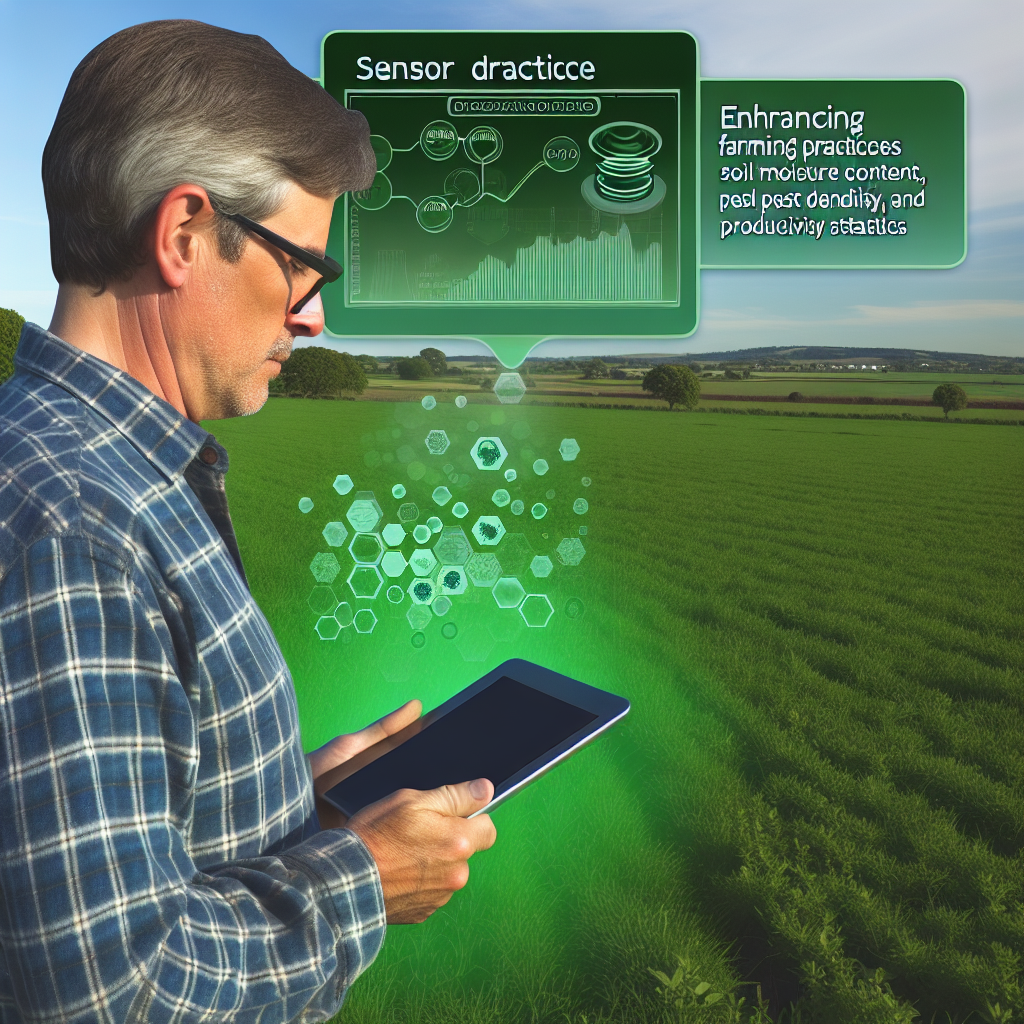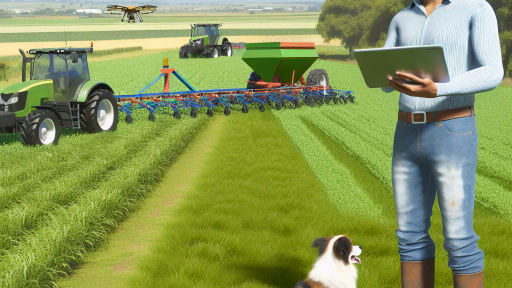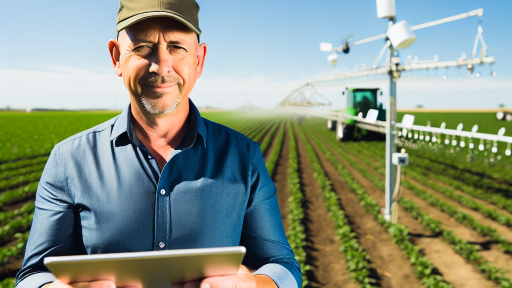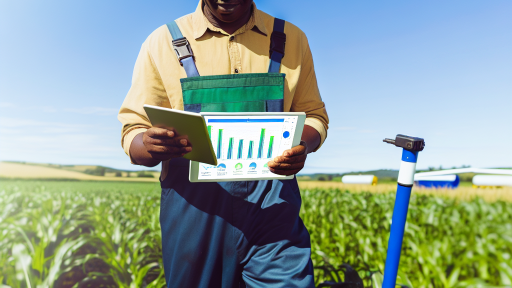Introduction to Precision Farming and Its Importance
Precision farming optimizes agricultural practices using technology.
It enhances crop yields while minimizing resource waste.
This approach utilizes data from various sensors and equipment.
Farmers can make data-driven decisions for better crop management.
The importance of precision farming cannot be overstated.
Benefits of Precision Farming
Precision farming increases efficiency and productivity.
It reduces the use of fertilizers and pesticides.
This leads to less environmental harm.
Farmers achieve higher profitability with lower input costs.
Modern technology drives sustainable growth in the agricultural sector.
Technology in Precision Farming
Drones and satellite imagery play crucial roles in data collection.
These devices provide real-time information about crop health.
Soil sensors offer insights into moisture and nutrient levels.
Farm management software helps integrate this data effectively.
Farmers can monitor conditions closely and respond quickly.
Transform Your Agribusiness
Unlock your farm's potential with expert advice tailored to your needs. Get actionable steps that drive real results.
Get StartedChallenges and Considerations
Implementing precision farming requires investment and training.
Some farmers may face technology adoption barriers.
Data privacy and security issues must also be addressed.
Collaboration among stakeholders can help overcome these challenges.
Education and support are vital for successful implementation.
Overview of Sensor Technologies Used in Agriculture
Introduction to Sensor Technologies
Sensor technologies play a crucial role in modern agriculture.
They enhance efficiency and productivity on farms.
By collecting data, these devices provide necessary insights.
Types of Sensors in Agriculture
There are various sensor types deployed in farming practices.
Each type serves a distinct purpose in data collection.
- Soil moisture sensors monitor soil water content.
- Temperature sensors track environmental conditions.
- Crop health sensors assess plant vitality.
- Pest detection sensors identify insect activity.
Benefits of Utilizing Sensors
Utilizing sensors improves decision-making in farming.
Farmers can optimize irrigation through moisture readings.
Additionally, they can reduce pesticide use with pest detection.
This leads to healthier crops and sustainable practices.
Integration with Other Technologies
Sensor data can integrate seamlessly with other technologies.
Agricultural machinery can adjust based on sensor inputs.
Moreover, data analytics software helps interpret sensor data.
This integration enhances overall farm management.
Types of Sensor Data Valuable for Precision Farming
Soil Moisture Sensors
Soil moisture sensors provide crucial data about water levels in the soil.
They help farmers optimize irrigation practices effectively.
These sensors minimize water usage and improve crop health.
Moreover, soil moisture data aligns irrigation with crop needs.
Weather Station Data
Weather stations collect valuable atmospheric data for farmers.
They monitor temperature, humidity, rainfall, and wind speed.
Showcase Your Farming Business
Publish your professional farming services profile on our blog for a one-time fee of $200 and reach a dedicated audience of farmers and agribusiness owners.
Publish Your ProfileThis information helps in making informed farming decisions.
Additionally, it aids in predicting pest infestations and disease outbreaks.
Crop Health Sensors
Crop health sensors use remote sensing technology.
They detect plant stress due to pests, diseases, or nutrient deficiencies.
These sensors provide timely alerts to farmers.
As a result, farmers can take action before damage escalates.
GPS Technology
GPS technology significantly improves field mapping and planning.
It enables precise planting and fertilization practices.
Farmers can track equipment and field activities closely.
This technology increases efficiency and reduces waste.
Yield Monitors
Yield monitors track the amount of crop harvested in real-time.
They provide valuable insights into crop performance across fields.
Farmers can analyze this data for future planting decisions.
Additionally, yield data helps in assessing overall farm productivity.
Gain More Insights: How Blockchain Is Making Farm-to-Market More Transparent
Integrating Sensor Data with Farm Management Systems
Understanding Sensor Data
Sensor data refers to real-time information collected from various agricultural sensors.
This information includes soil moisture levels, temperature, and crop health status.
Integrating this data enhances decision-making and operational efficiency on farms.
Farm Management Systems Overview
Farm Management Systems (FMS) provide tools for farmers to manage their operations.
These systems integrate various aspects of farming, including financials, planning, and monitoring.
Combining FMS with sensor data allows for a seamless workflow.
Benefits of Integration
- Improved Resource Allocation
- Enhanced Yield Prediction
- Increased Operational Efficiency
Farmers gain insights into resource usage through integrated sensor data.
This leads to more accurate yield predictions based on real-time conditions.
Additionally, it streamlines operations, reducing labor and time costs.
Implementation Strategies
Choosing compatible sensors is crucial for effective integration.
Farmers should focus on sensors that provide valuable insights relevant to their needs.
Establishing a user-friendly data management platform enhances accessibility.
Training team members on how to utilize the technology effectively is essential.
Data Analysis and Reporting
Effective analysis of sensor data leads to actionable insights.
Implementing advanced analytics can unveil hidden patterns.
Regular reporting ensures that farm management stays informed about performance.
Utilizing data analytics can significantly improve decision-making processes.
You Might Also Like: Types of Crop Monitoring Sensors You Need
Case Studies: Successful Applications of Sensor Data in Farming
Introduction to Sensor Technologies
Sensor technologies revolutionize modern agriculture.
They provide real-time data, enhancing decision-making.
Farmers leverage these tools for various applications.
Case Study: Precision Irrigation in California
In California, farmers implemented sensor-driven irrigation systems.
These systems measure soil moisture levels continuously.
As a result, water usage decreased significantly.
Moreover, crop yields improved due to optimal moisture levels.
Showcase Your Farming Business
Publish your professional farming services profile on our blog for a one-time fee of $200 and reach a dedicated audience of farmers and agribusiness owners.
Publish Your ProfileCase Study: Crop Monitoring in the Midwest
Midwestern farmers adopted drones equipped with sensors.
These drones collect data on crop health and growth patterns.
Consequently, farmers can identify nutrient deficiencies swiftly.
This information allows timely interventions to enhance yield.
Case Study: Livestock Health Monitoring
Farmers in Texas utilize wearable sensors for livestock.
These devices track animal health and activity levels.
By monitoring behavior, farmers detect illness early.
This proactive approach results in reduced veterinary costs.
Case Study: Pest Management Strategies
In Florida, sensor data aids in pest management.
Farmers use traps connected to sensors for monitoring pests.
This approach minimizes pesticide usage based on pest activity.
As a result, farmers experience both cost savings and environmental benefits.
Future Applications of Sensor Data
The future holds even greater potential for sensor data in farming.
Innovations such as AI integration will enhance decision-making.
Farmers can expect more precise recommendations for crop management.
Furthermore, emerging technologies like IoT can connect devices seamlessly.
Uncover the Details: The Role of Drones in Precision Agriculture

Challenges and Limitations of Using Sensor Data
Data Accuracy and Reliability
Sensor data plays a critical role in precision farming.
However, inaccuracies in data can undermine its effectiveness.
For instance, faulty sensors may provide misleading readings.
This situation can lead to poor decision-making by farmers.
Moreover, environmental factors can affect sensor reliability.
Rain, humidity, and temperature fluctuations may disrupt signals.
Integration with Existing Systems
Integrating sensor data with current farming systems remains challenging.
Many farms utilize various software platforms and tools.
These systems often do not communicate effectively with sensor data.
Additionally, farmers may lack the technical expertise for integration.
As a result, the potential of sensor data could be wasted.
Cost Considerations
Implementing sensor technology involves significant financial investment.
Many small-scale farmers may find these costs prohibitive.
Furthermore, ongoing maintenance and calibration add to expenses.
The return on investment may not be immediately apparent.
This uncertainty can deter farmers from adopting sensor technologies.
Data Management and Analysis
Collecting sensor data generates vast amounts of information.
Managing this data effectively poses a significant challenge.
Farmers need tools to analyze and derive meaningful insights.
However, many lack the analytical skills required for data interpretation.
This knowledge gap can hinder informed decision-making.
Privacy and Security Concerns
As farms embrace technology, privacy and security issues arise.
Farmers may worry about unauthorized access to their data.
Showcase Your Farming Business
Publish your professional farming services profile on our blog for a one-time fee of $200 and reach a dedicated audience of farmers and agribusiness owners.
Publish Your ProfileEnsuring data protection requires robust cybersecurity measures.
Such measures can add complexity and costs to sensor implementation.
This concern can lead to reluctance in adopting new technologies.
Explore Further: How Precision Agriculture Enhances Farm Efficiency
Future Trends in Sensor Technology for Precision Agriculture
Advancement in Sensor Capabilities
The capabilities of sensors are rapidly advancing in precision agriculture.
Innovative developments include enhanced miniaturization and cost reduction.
These advancements enable farmers to deploy more sensors across vast areas.
Moreover, refined sensors can detect subtle changes in soil and crop conditions.
Consequently, farmers can make data-driven decisions swiftly and accurately.
Integration with IoT
The integration of sensors with the Internet of Things (IoT) is transforming agriculture.
Farmers now utilize real-time data from multiple sensors for better management.
This integration fosters smarter farming techniques and resource allocation.
Furthermore, these systems offer remote access to vital agricultural data.
As a result, farmers can oversee operations from any location.
Use of Artificial Intelligence
Artificial intelligence (AI) is revolutionizing sensor data analysis.
Machine learning algorithms improve the accuracy of data interpretation.
These algorithms can identify patterns that human analysts might overlook.
Consequently, predictive analytics can help in anticipating crop needs.
This proactive approach aids in optimizing yield while minimizing waste.
Emphasis on Environmental Monitoring
Environmental monitoring has become a crucial aspect of agriculture.
Sensors now track climate conditions, soil moisture, and nutrient levels.
This monitoring allows for better understanding of environmental impacts.
Farmers can respond promptly to changing weather patterns or soil conditions.
As a result, sustainable practices can be implemented more effectively.
Challenges Ahead
Despite advancements, challenges in sensor technology persist.
Data security and privacy remain significant concerns for farmers.
Additionally, the need for maintenance of sensor networks is critical.
Farmers must also navigate the complexity of data integration platforms.
Overall, addressing these challenges will ensure successful implementation.
Best Practices for Implementing Sensor Data in Farming
Choosing the Right Sensors
Selecting the proper sensors is essential for successful implementation.
Consider the specific needs of your farm.
Evaluate factors such as crop type, soil conditions, and climate.
For instance, moisture sensors can optimize irrigation.
Likewise, temperature sensors enhance climate control.
Integrating Sensor Data into Existing Systems
Combine sensor data with your current farming management systems.
Utilize cloud platforms for data storage and analysis.
Ensure compatibility between different technologies.
This integration allows for a more comprehensive view of farm conditions.
Additionally, it facilitates timely decision-making.
Training and Education
Provide training for staff on sensor technology maintenance.
Showcase Your Farming Business
Publish your professional farming services profile on our blog for a one-time fee of $200 and reach a dedicated audience of farmers and agribusiness owners.
Publish Your ProfileEmpower farmers to understand and interpret data accurately.
Conduct regular workshops to reinforce skills and knowledge.
Utilize online platforms for ongoing education resources.
Effective training maximizes the benefits of sensor data.
Establishing Monitoring Protocols
Create protocols for regular monitoring and data collection.
Schedule routine checks for sensor functionality.
Integrate alerts for abnormal readings to enhance response time.
Ensure data is collected consistently over time.
This approach supports data-driven decisions and improvements.
Data Analysis and Reporting
Analyze sensor data to identify trends and patterns.
Utilize software tools for data visualization.
Reports should summarize critical insights for stakeholders.
Encourage collaboration among team members for effective discussions.
This practice allows for strategic planning and future forecasts.
Continuous Improvement and Feedback
Adopt a culture of continuous improvement within your farming operation.
Gather feedback on sensor performance from users regularly.
Use this input to make necessary adjustments and upgrades.
Encourage openness to new technologies and methodologies.
This adaptability fosters a sustainable farming environment.
Additional Resources
Agriculture Innovation: 10 Tech Trends to Watch in 2023 …
The Environmental Benefits of Precision Agriculture Quantified …




